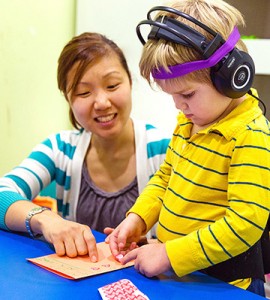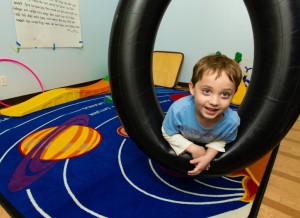Auditory Defensiveness and The Role of an Occupational Therapist
What is Auditory Defensiveness, how are some children affected, and what role does an Occupational Therapist play in treatment?

Commonly, when parents and teachers find out that I am a Sensory Integration trained Occupational Therapist, they will ask questions about either sound sensitivity or touch sensitivity. They will tell me about a child who seems unsettled or distressed in loud environments, frequently covers their ears to sounds that other children tolerate, are bothered by noises made by everyday things like vacuum cleaners and hair dryers, or avoids activities that have loud environments such as parties, ballgames, and movies. These children often ask, “Did you hear that? – What’s that noise? – Who’s talking?”, when the parent doesn’t hear anything at all. Parents may also share that their child seems overly sensitive, is anxious in new environments, needs more protection from the world, and exhibits tactile and or movement sensitivity. What these parents are describing is a condition known as “auditory defensiveness”.
When the World Gets Too Loud
Auditory defensiveness is a clinical condition in which a child is highly sensitive to sound. This means that sounds and voices that would not register at all, or would not be perceived as irritating to a typically functioning nervous system, are perceived by the child as too loud, too high pitched, or otherwise difficult to tolerate, and so he must defend himself against them. The child that is moving through their day in a defensive mode can often struggle to stay calm enough to play with friends, learn at school and be part of a family dynamic at home. To survive they may learn to cope by tuning out, hyper-focusing on something else, holding their hands over their ears, attempting to escape the situation in which they find themselves , or by acting out in such a way that the adults are left no choice but to remove them from the situation. Many times the adults around the child will identify a behavior challenge while not always identifying the root. They may struggle to believe that the auditory issue is real for the child, as their nervous system perceives the incoming sound information differently and without struggle. It may be extremely difficult if a sibling close in age is able to process typically, and therefore presents with more flexibility, and overall, an easier child to parent.
A child with auditory sensitivity is alerted to noises that a typically functioning nervous system would recognize as irrelevant and filter out, and may respond to them as if those things were a cause for alarm. As an adult I will equate this to the cocktail party experience. You are often juggling a plate of food, a glass of wine and a conversation with a new person. There is always a lot of back ground noise. For some adults this is not hard work for their ears. For my nervous system, on the other hand, it can be exhausting. I often feel tired from concentrating on the conversation while simultaneously attempting to filter foreground from background sound.
It’s tough to navigate school as well, when your hearing is so sensitive. For the pre-schooler, the classroom often sounds like a cocktail party—lots of children talking at the same time coupled with conflict situations that may include an upset child. For the elementary school aged child the sounds of the bells, children shouting, the echoing noise of the bathrooms or auditorium, the chaos of the playground and the cafeteria, are all experienced as an assault, and will put a child whose hearing is ultra-sensitive on high alert and force him to stay in that mode.
It is very hard to stay calm, regulated and ready to learn, problem solve and share, when your nervous system is in a constant state of alert. For the majority of the school day, children are listening to a teacher’s voice (often a female voice), and for many children the most challenging types of auditory defensiveness is sensitivity to high pitched sound. A high frequency sound dissipates in the air faster than low frequency. Attuning to the teacher’s voice and then holding on to the directions can be difficult, creating additional learning challenges for the child.
A child with auditory defensiveness may also be experiencing other development and/or learning challenges. There are several ways that sensory integration  therapy can help a child with auditory defensiveness. An occupational therapist with advanced practice will be able to assess and treat by improving the ability of the inner ear to do the job of filtering and dampening sound. This is done by providing the child with intense movement experiences. Movement affects the workings of the inner ear, which in addition to filtering sound, is responsible for monitoring where we are in space. As one system improves, so does the other. Occupational therapists with additional training can prescribe special filtered music, like the kind used in “The Listening Program”, that trains the ear and brain to be less sensitive to sound. This music can be very helpful to children who have trouble attending in noisy environments.
therapy can help a child with auditory defensiveness. An occupational therapist with advanced practice will be able to assess and treat by improving the ability of the inner ear to do the job of filtering and dampening sound. This is done by providing the child with intense movement experiences. Movement affects the workings of the inner ear, which in addition to filtering sound, is responsible for monitoring where we are in space. As one system improves, so does the other. Occupational therapists with additional training can prescribe special filtered music, like the kind used in “The Listening Program”, that trains the ear and brain to be less sensitive to sound. This music can be very helpful to children who have trouble attending in noisy environments.
Sensory integration therapy works on improving the way that the nervous system function registers, integrates and processes sensory input. An occupational therapist trained in sensory processing employs specific techniques that may include integrating primitive reflex patterns that can often support development.
There are also strategies, that when designed for the individual child and his/her environment, are often referred to as a sensory diet. These strategies may include:
- Modifying the environment (such as in a school) by considering the acoustics in the classroom. Changing seating arrangements may be beneficial and limiting extraneous noise from the hallway by closing the door or windows is also helpful. It may be necessary to cover the loud speaker with material to tone down the volume.
- Having rugs or carpet on the floor will decrease echo and extraneous noises.
- Whenever possible, children should be given advance notice about bells, announcements, fire drills, etc.
- Having the child wear headphones or earmuffs that cover the entire ear to filter out extraneous background noises.
- Playing calming music such as Mozart in the headphones or as background music.
- If concentration is an issue, the child should chew gum, suck on sour candies, and/or eat fruit roll ups, or crunchy snacks.
Generally speaking, a smaller, quieter, more structured classroom is a better fit for a sensory defensive child. I also advise parents not to expect their child to be able to tolerate concerts or to endure long stays at noisy family gatherings until the problem is corrected.
I am often asked if the problem is permanent. Auditory sensitivity may or may not go away, but with appropriate intervention, it should at least, diminish. Sometimes children grow out of their defensiveness and sometimes sensory integration therapy can eradicate it completely. Devising coping strategies, like keeping earplugs and something to chew on in your child’s backpack, helps him feel more in control.
Remember our children need us to play detective. Find out the reason for the behavior. Believe that is it often real for them, even if you don’t feel it, and try to put strategies in place to keep their nervous system calm.
And, as always, you’re not alone. If you have any concerns about your child’s auditory sensitivities, seek out the expertise of a sensory integration trained occupational therapist – they can help make life better for your child and your family.
Frequently Asked Questions about the Role of the Occupational Therapist in Sensory Integration

